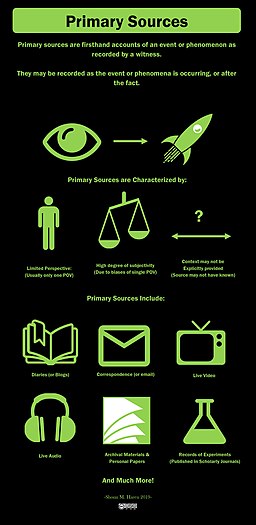

(William Godwin, Godwin Journal, Public Domain)
Imagine if the information world we live in today had no categories, no groupings, or labeling of any informational items. How would we find information? How would we organize information? How would we even understand the information being presented to us? Luckily for us, this world does not exist. Categories exist to help us sift through information with precision and efficiency. How else could we determine "fiction" from "nonfiction", or a "magazine" from a "book", "audio" from "video"?
Categories come in handy when it comes to research. We need categories to help us in our approach to researching various topics. In order to properly use them, though, we need to first start with understanding the differing viewpoints in which information is presented to us.
In this module, we will take a look at some distinguishing characteristics of primary, secondary, and tertiary information sources.
After completing this module, you will be able to:
Think of the word "primary" just on its own. When we were young, we went to "primary schools". Our parents or guardians are our "primary" caregivers. The word "primary" can either mean "first" or "earliest", and that's exactly what *primary sources* are. Primary sources are those sources we rely on for firsthand information. The information contained in primary sources is unedited, meaning it's original and hasn't been picked apart yet. Any type of information that is original and uninterpreted is a primary source.
Primary information sources are firsthand materials, in their original form. Examples include:
Primary sources often enable the researcher to experience the flavor of the original event or information, rather than relying upon someone else’s interpretation. Keep in mind that primary sources, because of their first-hand nature, may not be completely well-reasoned, objective, or accurate.
Secondary sources are those sources that provide more developed information on primary sources. They gather, analyze, interpret, or repackage information from primary sources and/or other secondary sources. The information comes to us secondhand. Authors of secondary sources did not directly participate in the composing of the primary source, but they are experts regarding the primary source. Examples of secondary sources include:
Secondary sources can provide valuable interpretation or historical context, provided the sources are trustworthy.
Sometimes secondary sources can be used as primary sources. For example, a textbook is typically a secondary source if you are relying on it for the information it contains. However, if you are reviewing textbooks and how the content in them is curated, then the textbooks you use become primary sources. So, if you are using a second source for its content, then it is a secondary source, but if you are using the source for how it is created, then it is a primary source. This rule applies to tertiary sources (see below) being used as primary sources, too.
Tertiary sources typically provide a summary or overview of information found in primary and secondary sources. Tertiary sources provide overviews of topics by compiling and synthesizing information gathered from other resources. In other words, they are often similar to the end product you are likely to be asked to produce for your writing assignment. Tertiary sources are typically most beneficial as you start to do research to simply learn more about your topic. They will often list the primary and secondary sources used to create the summary in a reference section. These references are often better sources of information for your research than the tertiary source itself. Examples of tertiary sources include:
| Primary | Secondary | Tertiary |
|---|---|---|
| Statistical table of public school teachers' salaries | Article describing trends in teachers' salaries |
Index of sources for finding statistical information |
| A reproduction of the Declaration of Independence | Book exploring the history and political thought behind the Declaration of Independence |
Almanac explaining documents, symbols, and anthems of the United States |
| Speech by well-known business leader | Biography of business leader | Textbook on human resources management |
| Physical evidence in a court trial | Lawyer’s closing remarks/argument | Dictionary of criminal justice |
| Results of a treatment trial testing a new antidepressant on elderly men | Book about treating depression with changes in diet and exercise | Manual with practical tips for working with elderly patients with depression |
| Blockbuster movie filmed in 2012 | Biography of the lead actor | Guide about the movie |
| Original artwork, perhaps a sculpture |
Critique of that sculpture | Wikipedia about 19th Century sculpture |
| Notes taken by a clinical psychologist | Magazine article about the psychological condition |
Textbook on clinical psychology |
(Twin Cities Campus Libraries, 2013)
| Primary Sources Infographic | Secondary Sources Infographic |
|---|---|
 |
 |
(Shonnmharen, Primary Sources, Secondary Sources, CC BY-SA)
Check out this video below for a better understanding of primary and secondary sources.
(Vossler, 2016)
The content for this module is drawn from the following sources:
Cabrillo College. (n.d.). Information literacy course in Canvas. https://cabrillo.instructure.com/courses/15592/modules
Twin Cities Campus Libraries. (2013, February). Primary vs. secondary sources. https://confluence.ihtsdotools.org/download/attachments/72060108/primary.pdf?version=1&modificationDate=1535666659000&api=v2
University of Toledo Libraries. (2020, March 13). Quality teaching & learning: Information literacy in Blackboard. https://libguides.utoledo.edu/QTL/blackboard
Vossler, J. (2016). Primary v. secondary sources [Video]. Vimeo. https://vimeo.com/210805872
Now that you know how to distinguish primary, secondary, and tertiary sources, you will need to locate one of each type related to your research topic.
Either in the textbox in the LMS or in a Word document, do the following:
See the Google doc here for quiz questions and answers. Please note, this document is stored on the PALNI team drive and is only accessible to those who work in a PALNI school.
All of the PALNI Information Literacy Modules are licensed under a Creative Commons Attribution 4.0 International License.